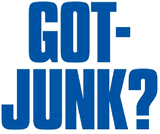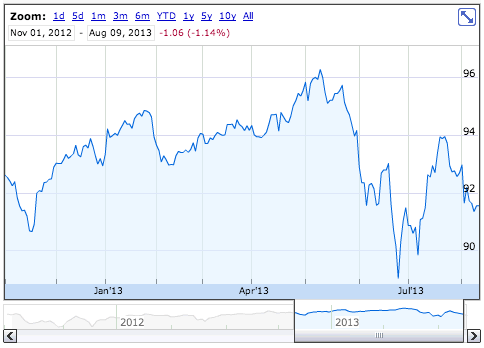 Yesterday, I posted a 9-month update on my $10,000 P2P lending portfolio with loans from Prosper and LendingClub. Every so often it is pointed out that lending unsecured money directly to random people at high interest is not very safe, and you could just invest in junk bonds from shakier companies instead.
Yesterday, I posted a 9-month update on my $10,000 P2P lending portfolio with loans from Prosper and LendingClub. Every so often it is pointed out that lending unsecured money directly to random people at high interest is not very safe, and you could just invest in junk bonds from shakier companies instead.
“Junk” bonds, also known as High Yield bonds, are bonds from companies which have earned a credit rating from one of the major rating agencies that is worse than the “investment-grade” tier. Perhaps the company already has a lot of debt, or its balance sheet is otherwise worrisome. Bonds from some pretty big and well-known companies have been rated junk from time to time.
This is not a detailed analysis and not even technically an apples-to-apples comparison, but I ran some quick numbers to satisfy my own curiosity. The iShares iBoxx $ High Yield Corporate Bond ETF (HYG) is the largest high yield US corporate bond ETF, with over $15 billion in assets and an expense ratio of 0.50%. Here’s a chart of the credit rating breakdown of the portfolio, taken from their latest Q2 2013 factsheet.
HYG tracks an index of high yield corporate bonds and has an effective duration of 4.26 years. I note this because both Prosper and LendingClub have 3 and 5 years loans, making them in the same ballpark assuming you continuously reinvested your interest into a ladder of loans.
If you bought $10,000 worth of HYG on the 11/1/2012 closing price of $92.54 a share, you’d have 108.06 shares. To simplify the math, let’s just say you can own fractional shares with your broker, you held the entire time, and you just kept the interest instead of automatically reinvest dividends. Though 8/11/2013, each share distributed $4.367 in interest. Times 108.06 shares, that’s $471.90 in earned interest. At the close of 8/9/12, HYG’s share price was $91.57.
Therefore, your 108.06 shares would now be worth $9,895.05, slightly less than your original $10,000. Adding in the interest earned, your total would be $10,366.95. If you reinvested dividends, your total would have been a few dollars higher.
To get an idea of volatility, here’s the price chart for HYG from 11/1/12 to 8/9/13, taken from Google Finance.

The total from my Prosper and LendingClub balances from the same time period was 5,325 + 5,264 = $10,589. Again, this isn’t a proper comparison because this value doesn’t necessarily represent the value of the P2P loans on an open market. It appears that HYG was hurt a bit by rising interest rates. I don’t know if this would affect how much people would pay for my Prosper or LendingClub loans on the FolioFN secondary market. The only way to find out would be to actually sell them, although maybe there is a way to make a good estimate.
 The Best Credit Card Bonus Offers – 2025
The Best Credit Card Bonus Offers – 2025 Big List of Free Stocks from Brokerage Apps
Big List of Free Stocks from Brokerage Apps Best Interest Rates on Cash - 2025
Best Interest Rates on Cash - 2025 Free Credit Scores x 3 + Free Credit Monitoring
Free Credit Scores x 3 + Free Credit Monitoring Best No Fee 0% APR Balance Transfer Offers
Best No Fee 0% APR Balance Transfer Offers Little-Known Cellular Data Plans That Can Save Big Money
Little-Known Cellular Data Plans That Can Save Big Money How To Haggle Your Cable or Direct TV Bill
How To Haggle Your Cable or Direct TV Bill Big List of Free Consumer Data Reports (Credit, Rent, Work)
Big List of Free Consumer Data Reports (Credit, Rent, Work)
You are dead right that the high yield bonds and the ETF of HY are marked to market. Presumably your loans are also worth a little less now than they were at origination because rates have crept up. But those sites mark them at par as long as they are performing.
The other thing to keep in mind is that duration and average maturity are not the same thing (in a bond with coupons). A 10-year bond today has a duration probably between 5 and 6 years right now, maybe a little lower. Your portfolio of 3 and 5-year loans probably have a duration below three years and that is probably pushed even lower because of the prepayments I’d expect from these kinds of loans. So your lending portfolio probably has less interest rate risk than the HY ETF, which is a good thing.
Another thing to consider is if these high yield bonds do in fact default, there often will be recoveries in the restructuring or bankruptcy process that could get you 10%, 30%, 50%, or more of your money back. So the defaults are not totally losses, and I was wondering if that’s the case with the P2P lending platforms. It could make a big difference in your total return how those defaults are resolved.
I have been invested in VWEHX since 2006 and I’m happy with my returns. Despite a major drop in share price in 2009 and a full recovery today, this fund has seen no defaults according to prospectus… not sure how they managed to pull that off. I have seen the interest rate fluctuate between 4.5-13% to make up for the share price drops, thus generating a fairly consistent revenue stream. In other words, as price goes down interest goes up, and vice-versa. I’ve started to see this fund as an annuity in terms of the monthly cash it generates, and not as volatile as p2p lending. When I tried Prosper it ended up being a waste of time and effort. I have cautiously started again with Lending Club hoping that I can start taking p2p as a serious investment vehicle, and not just a roll of the dice. Only time will tell… by the way, thanks for providing your p2p portfolio updates!
I think it’s also worth putting the share price in HY bonds (HYG, JNK) in perspective of a massive run-up last year while bond rates kept reaching historical lows.
Knowing that one was in such a market, it takes a lot of courage to establish a new position or to materially increase one’s exposure to fixed income securities late 2012. However, I have been very pleased with JNK’s performance since when I bought it in mid-2011. I’ve also traded it a little bit in 2013 to help preserve some returns.
When the 10-year rates started to increase consistently, I bailed out when JNK dropped from $41 to near $40. I bought the shares back when it dropped to about $39, and sold when it closed back above $40.50. I bought again at around $39.80 and sold at $40.74. Lasttly, I bought back into it just north of $40 again – so yes, I’ve taken a little hit this time around… but not massively so. I may have only missed one monthly dividend payment (around $0.20.)
I figure I don’t need to use this money anytime soon, and combined with a reasonable 401(k) asset allocation, it feels good to have the kind of yields junk bonds give, with the freedom to trade them on the open market.
I might just ride through the rate rollercoaster on the way down, unless the bonds firm up a bit from here. I have the sense that the Fed tapering programme isn’t going to have a dramatic impact on rates, let alone being a long time off before they actually increase the Federal Funds rate. I’m okay with a 6-7% yield.
Dont trust the ratings agencies. They rated detroit muni bonds “A” right up to the end. We all know what happened then.
I’ve been invested in JNK (very similar to HYG) for a while. I’ve often wondered if I should have put a lot more money into something similar to Lending Club. Good analysis – hopefully it will help steer some folks in the right direction.
Lending Club isn’t really an option at this time. The investor demand and institutional involvement, plus automated buying is so intense, they’re only posting around 100-150 loans four times a day and anything you’d want to put money into is gone in about 30 seconds or less.
I wasn’t actually able to buy more than a few loans a week until I got into the habit of setting an alarm to go off a few minutes before the ‘drops’, and I’m only able to get anything by selecting all notes and putting a low dollar fraction of each into my cart, clicking as fast as I can, then discarding what I didn’t want. Even then I can get maybe 2-4 notes per drop, and at least one or two of those I feel are borderline.
Its simply implausible to deploy capital into the p2p market at this time, unless you’re willing to sock big money into each note and leave diversification behind. Not particularly recommended.
Too many lenders, not enough borrowers and the marketing efforts to bring in new borrowers are weak. Nobody I know has ever even heard of it, let alone considered it for either lending or borrowing.
Your alternative is turning your LC username and password to someone you don’t know with an automated buying service, building your own, or going with something like LC’s “prime” service, which doesn’t let you filter on very much.
It was nice while it lasted…